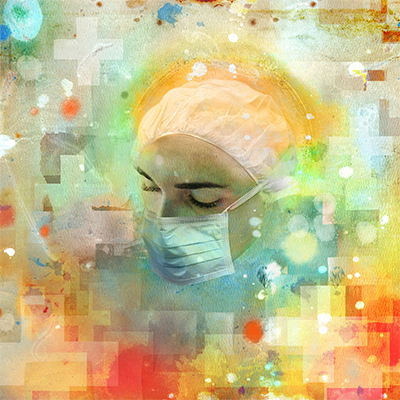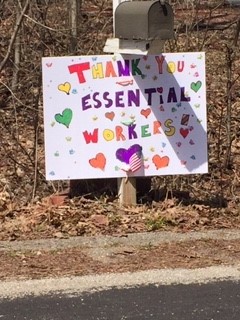BY: LAURA McKINNIS, MSN, NP-C

Illustration by Jon Lezinsky
I've worked in emergency medicine for 20 years and have come to believe the foundation of emergency medicine is problem solving: We see weird stuff and we figure out how to handle it. We first started seeing cases of COVID-19 in late February. That seems like a lifetime ago. The department was drowning in its normal, heavy volume, and then we lost use of COVID isolation rooms that needed extensive cleaning. As the fears of the coming pandemic grew, so did patient volume. It felt like we were always managing the problem a week too late. As soon as we adjusted, made space and found solutions, the testing protocol would change or the patient volume would shift or new concerns over availability of personal protective equipment (PPE) caused us to proceed in ways that never before would have been tolerated. But we keep adjusting.
The beginning of the crisis was marked with uncertainty. Every day was different. The rule of the game was this: The rules will constantly change. As soon as I became comfortable with the fluidity of the situation, the more easily I could tolerate a shift. The uncertainty and lack of direction at department, administrative and government levels resulted in a great deal of tension. I certainly have not behaved perfectly. During those early days I had two major confrontations with nursing staff over protocol and patient care. I felt the need to take control of the situation, which I thought was in desperate need of controlling. But I did not communicate calmly, and I did a poor job of explaining my rationale. Crisis reveals character. I found some deficiencies in mine.
As days went by, a strange, new way of interacting with patients developed. This disease is unseen and anyone could be carrying it. I could spread it to an elderly patient, a young man could spread it to me. I could infect my children. I am scared of this unseen thing that causes me to be a little scared of the people I treat. I've been afraid of patients in the past, but I could see that danger coming. Now the danger is everywhere and with everyone, even me.
One of the hardest moments I experienced involved admitting a 92-year old gentleman who most surely had COVID-19. He had a low oxygen saturation with rapid onset fever and mild cough. His chest X-ray was consistent with what we were just learning would be a diagnostic indicator of progressing disease. I knew he would likely decline rapidly and needed hospital admission. But our hospital had just initiated its strict no-visitor policy. His wife of 40 years would be unable to stay with him. The couple was very angry with me at the thought of separating. They had never spent a night apart. In fact, the man was willing to leave the ER against medical advice and go home to die rather than be separated from his wife. I saw the tenacity of their love and their fear of this disease. I knew my own father-in-law, who recently lost his wife, would have reacted exactly the same way. As I shared this with the couple, they both started to weep. I cried with them. I petitioned administration to let her stay, and they informed me that people were being admitted with strokes by themselves or recovering from surgery alone. People were dying alone. This was grim. Eventually the couple understood and made the difficult decision to separate.
My experience has been nothing compared to patients and clinicians in harder hit areas, such as Detroit and New York. I cannot imagine the emotional and physical pain they deal with every day. One of the biggest struggles for health care workers is the constant use of PPE. I am grateful that I have not had to go without equipment, but we are ever mindful of shortages. There have been shortages of supplies that have led to improper use of PPE. Staff in the ICU have been asked to do heroic work while reusing masks and gowns – a practice that is unacceptable and surely spreading disease. It's a problem that must remain top of mind as we move forward. Because of the lack of hospital supplies, a physician in my group generously purchased at her own expense goggles, stethoscopes, plastic shoes, bags, gowns and much more to keep us safe. We know the equipment is necessary, but it requires extensive time and care to use it properly. Masking, gowning and removing equipment must be done perfectly so as not to contaminate oneself or others. It is exhausting and uncomfortable. I get hives on my face after four hours of masking. Some of us have developed cuts and sores from its constant use. Because it takes so long to put on and take off, the use of PPE slows us down. I can be busy all shift and see only half my normal volume of patients because of the additional work. But we know it is essential: our lives, the lives of our patients and the health of our community are at stake. After a shift there is another task in cleaning equipment, driving home, undressing in the garage, leaving dirty clothes and shoes outside, running through the house to the shower before greeting my family. I haven't kissed my husband in a month.

Author Laura McKinnis says her neighbors across the street put this on their mailbox so she can see it when she comes in and out of the driveway. McKinnis says of the sign: "I love this!"
In addition to the medical challenges, the health care system, like every other industry, is feeling the financial impact of lost business. Emergency Department volume is down 40%. Surgical cases are down 80-90%. Our physician group has cut benefits, cut shifts and decreased hours. It is strange to be inside the most critical moment our health care system has ever experienced and still have to worry about the possibility of being laid off. The financial injury to our country is just as real as the physical disease, and the health care system is not immune.
Like every tragedy our country has faced, we find hope. The way we are responding to the pandemic is improving. Procedures and protocols are being refined, and we constantly adapt care as new research becomes available. It is fascinating to learn from the medical community around the world in real time. People are doing their part and staying home. I am deeply encouraged by the bravery, creativity and support both in our medical team and in our community. Neighbors sewed masks, packed boxes full of snacks and made signs to cheer us up. Patients thank us profusely for our service. I also want to add thanks to other essential workers, like our teachers. My kids' teachers are heroes for digging deep and finding creative ways to keep children engaged, learning and feeling safe and productive in these crazy times. We really are alone and yet together.
Anxiety about the future is a real and present part of every day. But strength, creativity and compassion can overcome tragedy. Through the world wars, depressions and natural disasters we come together to help and rebuild. Humans have a way of finding one another regardless of the barriers. We need to reach out and comfort one another even when we can't be together. It is difficult to console a patient you're caring for when you're behind a gown, a plastic shield and goggles. But I hope my patients can see compassion even through the masks.
LAURA MCKINNIS is a nurse practitioner specializing in emergency medicine. She has worked in emergency departments in Milwaukee, Wisconsin, and surrounding areas for years. Her website is www.medicineasministry.com.
Copyright © 2020 by the Catholic Health Association of the United States
For reprint permission, contact Betty Crosby or call (314) 253-3490.